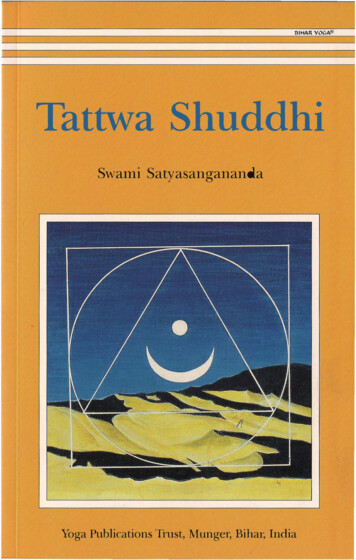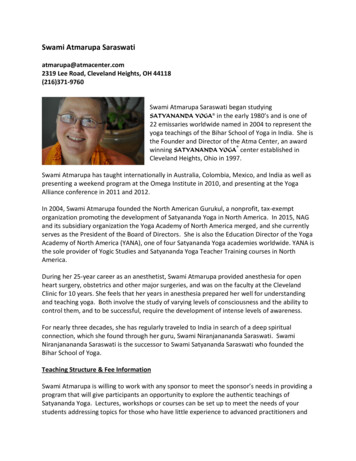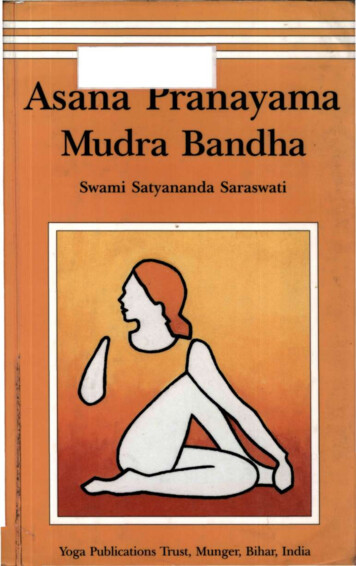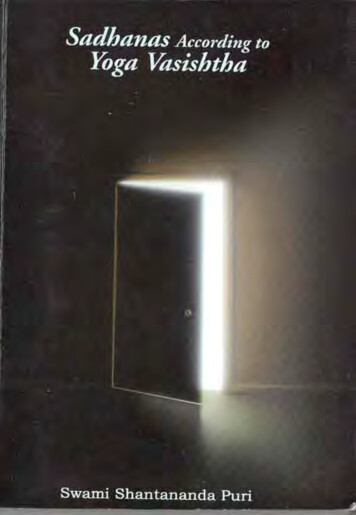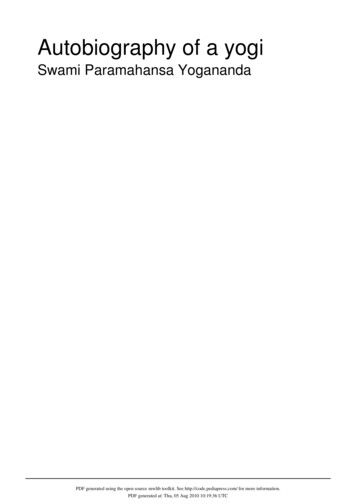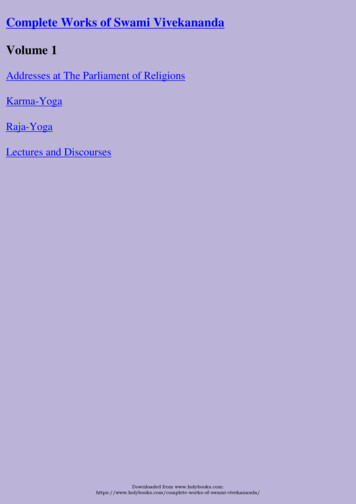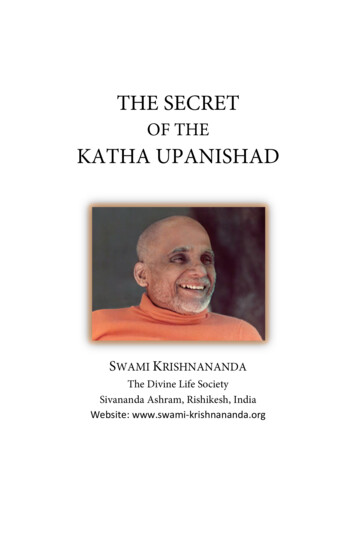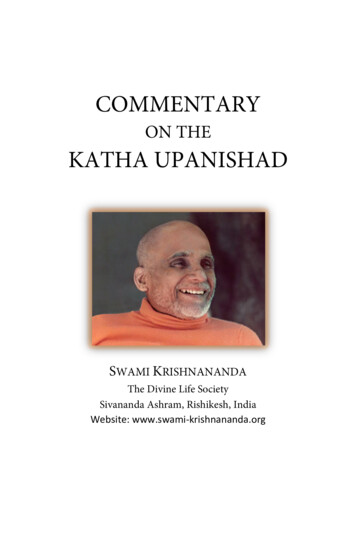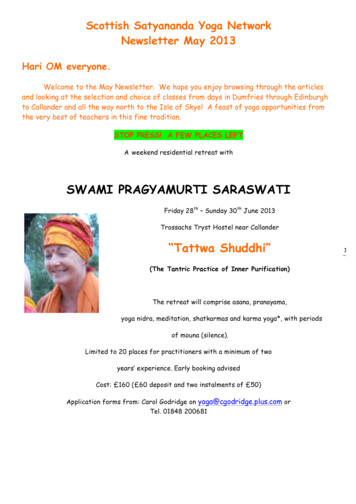
Transcription
Scottish Satyananda Yoga NetworkNewsletter May 2013Hari OM everyone.Welcome to the May Newsletter. We hope you enjoy browsing through the articlesand looking at the selection and choice of classes from days in Dumfries through Edinburghto Callander and all the way north to the Isle of Skye! A feast of yoga opportunities fromthe very best of teachers in this fine tradition.STOP PRESS! A FEW PLACES LEFTA weekend residential retreat withSWAMI PRAGYAMURTI SARASWATIFriday 28th – Sunday 30th June 2013Trossachs Tryst Hostel near Callander“Tattwa Shuddhi”(The Tantric Practice of Inner Purification)The retreat will comprise asana, pranayama,yoga nidra, meditation, shatkarmas and karma yoga*, with periodsof mouna (silence).Limited to 20 places for practitioners with a minimum of twoyears’ experience. Early booking advisedCost: 160 ( 60 deposit and two instalments of 50)Application forms from: Carol Godridge on yoga@cgodridge.plus.com orTel. 01848 2006811
Scottish Satyananda Yoga NetworkNewsletter May 2013*What is the importance of karma yoga?Karma Yoga – the yoga of selfless service – is an integral part of the experience of theweekend, part of the practice. Karma yoga was one of the four types of yoga introduced tothe west in 1892 by Swami Vivekananda. The Bhagavad Gita is regarded by somecommentators as the manual for karma yogis.“Perform work in this world, Arjuna, as a man established within himself-without selfishattachments and alike in success and defeat.Yoga is skill in action” (chapter 2)“Karma yoga should be done with a definite purpose. It should help bring about atransformation in attitude, behaviour and expression. Karma Yoga helps to enhance the abilityof the hands (hands meaning expression, creativity, co-ordination and co-operation betweenthe different areas of life). Any action which is performed with clarity of mind and properemotional balance is Karma Yoga.” On The Wings of The Swan Part 1 Swami Niranjanananda.“Karma yoga is not just selfless service or detachment from the rewards accruing from work,but work done with a higher level of concentration and awareness. Is your mind distracted bydesires, and ambitions, or is it one-pointed on the task you have been given?” Karma Sannyasaby Swami Satyasangananda (Satsangi)“You may practice raja, hatha, kundalini, mantra and bhakti yoga; but if you underestimatekarma yoga then all these yogas can lead you to a dissipated and dispersed state of mind.Everyone who is practising yoga should transform their daily activities through the philosophyof karma yoga”. Swami SatyanandaThe karma yoga we will do at the Tattwa Shuddhi retreat will consist of tasks such as mealpreparation, clearing up, and possibly other jobs suggested by the owners of Trossachs ------------------SAYINGS OF A PARAMAHAMSAYou have problems everywhere because the whole structure of thehuman personality is based on principles which do not have their basisin reality.There is no noise in the world. There is no peace in the Himalayas.Both are within you.2
Scottish Satyananda Yoga NetworkNewsletter May 2013Making Energy MoveLast year Carol Godridge undertook a project involving teaching Chakra awareness to moreadvanced level students, as part of her Satyananda Yoga Integration Course. In November2012 she presented some of these interesting results to colleagues, at a Yoga Scotland OGTday.Fundamental to yoga philosophy is the notion of universal energy, or prana which comprises, and iswithin, everything in the known world. We are therefore all connected by this energy to each otherand to the generality of prana around and within us.Ancient tantric wisdom about the Chakras and the subtle energy system has now been validated bymodern scientific thinking. Quantum physics is reintroducing ideas that were current in yogaphilosophy many thousand of years ago. Hiroshi Motoyama’s scientific research and his measuringinstruments have now demonstrated the existence of the chakras as the centres of the body’senergy systems and the link between the physical, astral and casual bodies, and with the universalenergy around us. 1 Deepak Chopra also describes it in modern terminology: “Because your bodyemanates electro-magnetic frequencies, you are yet another expression of this same field. Thepulsations of nerve signals racing along your limbs, the electric charge emitted by your heart cells,and the faint field of current surrounding your brain all demonstrate that you are not separate fromany form of energy in the universe. Any appearance of separation is only the product of the limitationof your senses, which are not attuned to these energies.”2As we humans have become more ‘civilised’, we have lost awareness of this connection, and becomeisolated in life rhythms and practices that are divorced from those of the natural environment. Wehave lost the ability to ‘tune in’ to the universal energy, to the frequencies of higher awareness thatrecharge our energies and enable us to live in balance and in communication. In most human beings theprimal energy lies dormant, with the result that we use a very small amount of our potential at anyone time. In the Hatha Yoga Pradipika it says that “if our perception were finely tuned to the pranicbody, we would see a light body in which there were thousands of fine, wire-like structuresconducting shakti”.3 The text goes on to describe the first steps in purifying the nadis and theenergy channels, by increasing the flow of prana and storing it in the chakras. “When the nadis arepurified, there are external symptoms. Success is definite when the body becomes thin and glows.”Not only will the body be radiant from the increased flow of energy, but it will lead to greater mentaland physical capacities.With yoga practice one can begin to re-awaken some of these faculties by stimulating the Chakras.As a yoga teacher I begin with students in their second year, explaining about the subtle er,India1993)p.13823
Scottish Satyananda Yoga NetworkNewsletter May 2013system, and describing the chakras as the junction points, which act like transformers, modifying thepower of the universal energy to a frequency that the human body, mind and consciousness can copewith. Each chakra is a switch which turns on or opens up specific levels of the mind.Beginners can learn to feel the chakras through asanas and simple breathing practices, and tounderstand how they relate to general health and well-being. But for students who have beenpractising regularly for at least a couple of years, who have experienced moving prana around thebody and have developed a level of awareness, something more is needed.This project was carried out in my monthly three hour workshops for Intermediate Level students,over a five month period. These workshops comprise a three hour programme of integrated chakraawareness through chanting, asana, pranayama, discussion, yoga nidra and meditation. The yoga nidravisualisations and the meditations specifically incorporated different aspects of chakra awareness.Nine students volunteered to commit themselves to an additional daily practice of about 20 minutesover a period of 14 weeks, and in each two week period they were given three daily practices to do,which they monitored and recorded.The results were very interesting indeed. All the students experienced significant movement ofenergy. Each one felt the energy in different ways. It was no surprise that the most significantenergy movements were felt in the lower chakras, where, according to Swami Satyananda, most of usare stuck. There were some fascinating details. With manipura chakra for example, one studentstarted to ‘comfort eat’ during that specific fortnight, two had stomach problems and one said thatafter each morning practice that fortnight, she was unable to eat any breakfast! None of thestudents had any prior knowledge of what might happen.The workshops were enjoyed by all those taking part and their feedback gave me confidence inteaching subtler practices. It has also given me a blue-print to build on in taking more advancedstudents further and, hopefully, some useful information to share with other teachers. To this end Ihave had copies, including six chakra balancing class plans, printed and bound for sale to anyinterested colleagues.The project Report, including all class plans and handouts is availableby post priced 10 from: Carol Godridge, Ben Doran, Ayr Street,Moniaive, Dumfriesshire, DG3 4HW.4
Scottish Satyananda Yoga NetworkNewsletter May 2013PRANAYAMA SADHANA COURSE3 weekends (non-residential)Dates: July 13th & 14th, September 7th & 8th and October 5th& 6th 2013Time: 10.00 – 17.00 each dayTutor: SWAMI VEDANTANANDA SARASWATISwami Vedantananda is an internationally known and loved teacher and one ofthe Guardians of Satyananda Yoga in Europe. Pranayama Sadhana is a six daycourse to develop personal practice, experience and understanding of thisimportant aspect of Yoga Sadhana.You will be given a daily home practice 20-30 minutes recommended readingVenue: Uphall Community Education Centre, Strathbrock Place, Uphall, West Lothian,EH52 6BN.Participants: open to experienced yoga practitioners and yoga teachersCost: 420 – ( 120 deposit to secure place and payment of the balance before the start ofthe course)Information leaflet and booking form from Jayanti (Jane Russell)9 Hall Street, Galashiels, TD1 1PJEmail: info@janerussell.org Tel: 01896 7542785
Scottish Satyananda Yoga NetworkNewsletter May 2013Rescheduled first time visit to the south west by this much loved Satyananda teacher.A DAY OF MANTRA AND SOUND HEALINGWithSwami Nirmal SaraswatiFrom the London Satyananda Yoga CentreOpen to all levels of experience in yoga.University of Glasgow Crichton Campus, DumfriesSunday 23rd June 2013 10 am – 4 pmCost: 25. Please bring a packed lunch. Tea and coffee provided.Swami Nirmal says: “Mantras are specific sound vibrations. They can be used todirectly influence the mind, to bring healing, alter perception, heightenawareness and awaken the chakras. During the day we will use mantras in asana,pranayama and meditation techniques, as well as on their own, to promoteharmony of body, mind and spirit.”Phone or e-mail for application form: Carol Godridge Tel. 01848 200681 or yoga@cgodridge.plus.comCOME AND JOIN US FOR GURU POORNIMA – SUNDAY 21st JULY 2-6 pm - FREEIn yogic traditions, Guru Poornima is celebrated every year on or near the full moon day in July. Thisyear the full moon falls on Monday 22nd. So on Sunday 21st we’ll have an opportunity to pay our respectsand offer our heartfelt gratitude to all spiritual masters, past and present. The guru (giver of light orspiritual teacher) may be embodied in a living person or may be the principle that exists dormant in all ofus – the inner guru. We’ll celebrate at my house in Edinburgh. For details and to book email me onbijam.yogini@yahoo.co.ukBIJAM6
Scottish Satyananda Yoga NetworkNewsletter May 2013Yoga Workshops atThe Health Oasis, Isle of SkyeFacilitated by Meg MillerTeacher: KaliCost 40Workshop dates – June 1st, 10-5pmTopic - Yoga and CreativityThe workshop will involve simple yoga practices (asana), breath work (pranayama), deeprelaxation and visualisation (yoga nidra) as well as simple meditative practices. These will becoupled with creative work involving a variety of art materials both individually and in agroup. This workshop is open to all - those who feel they are beginners or have experience inart making or yoga. The aim of the workshop is to create an atmosphere that is stimulating,playful and non-judgemental in order to develop and enjoy one's intuition and creativeenergy.Kali is a qualified yoga teacher and has been practising yoga for 17 years. As well asbeing an artist, she is an art therapist with several years’ experience working withchildren and adults.Teacher: Guru Swaroop, Graham Whiting Workshop dates – June 22nd, 10-5pmCost 35Topic -LIFE CONNECTIONS - CONNECTING YOGA AND YOUR LIFEYoga is not just for the mat!This Satyananda Yoga workshop will encourage you to use the yoga that you already know andthat you can know, to support you and those around you in daily life. We’ll consider how yogacan calm, centre, strengthen and empower you. We’ll try some practices and techniques thatare useful and accessible. Then we’ll look at ways to use those in your daily life. Work inpractice sessions and the class feedback from those sessions will influence how the dayprogresses, so that the most useful and interesting practices for the class are found andworked on. The workshop will finish with a relaxing Yoga Nidra meditation and hand-outs ofsome of the key practices, to enable you to take the most from your day.Graham has practised Hatha and Raja yoga since his early teens studying SatyanandaYoga and Buddhist teachings for the last 12 years. Graham was named as karmasannyasin and given his spiritual name, Guru Swaroop, by Swami Satsangi, in Harrogatein 2009. He trained as a Satyananda teacher with Swami Pragyamurti, Sn. Amarajyotiand Lalitatambika in London and now teaches in Sheffield and Nottingham.He has particular interests in Yoga and sport and in community support activity, workingon employment projects in the Nottingham area. He is a Sport England, British Wheelof Yoga registered teacher and also a level 2 British Cycling coach.7
Scottish Satyananda Yoga NetworkNewsletter May 2013Tutor: LalitambikaCost 35Workshop date – 17th August, 10-5pmTopic - The KoshasLalitambika qualified as a Satyananda teacher with Swami Pragyamurti in 1990,following visits to the Satyananda Ashram in Bihar, India. She teaches in West Sussex,specialising in classes for older people a
The karma yoga we will do at the Tattwa Shuddhi retreat will consist of tasks such as meal preparation, clearing up, and possibly other jobs suggested by the owners of Trossachs Tryst hostel. ----- SAYINGS OF A PARAMAHAMSA You have problems everywhere because the whole structure of the human personality is based on principles which do not have their basis in reality. There is no noise in the .
